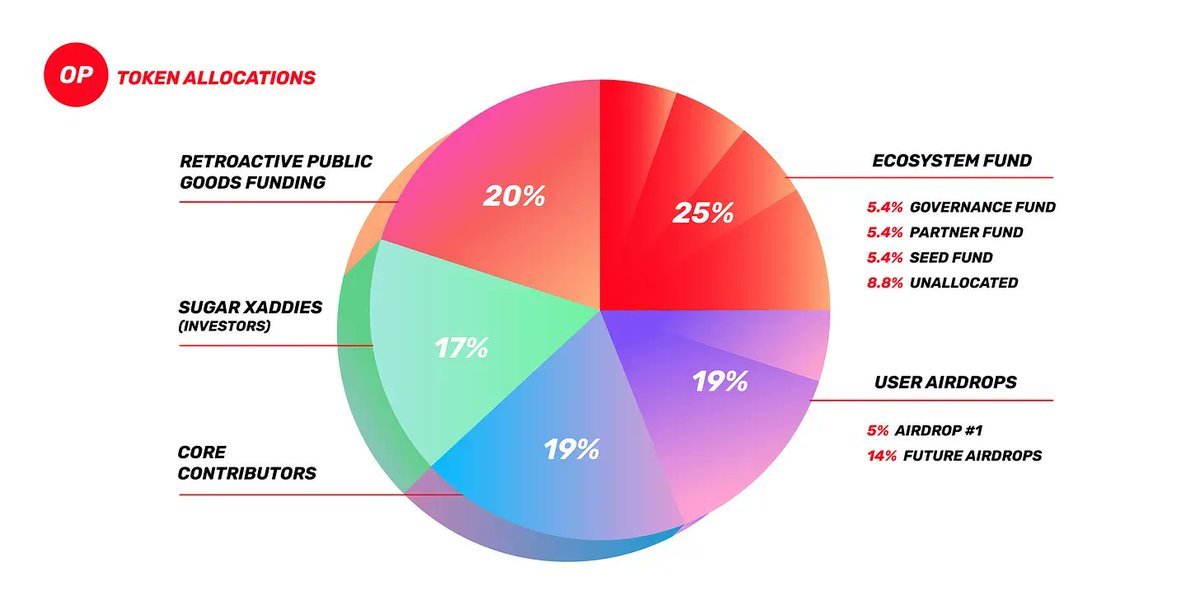A lot has changed in rollup economics since RPGF3 and EIP-4844...
These 2 events marked a new "season" for rollups.
And I've thought about this a lot more and looked at tons of data.
So I thought I'd revisit some of my predictions and evaluate what did/didn't come true!
↓
But first, a recap:
RPGF3 distributed more OP tokens than expected…

Builders realized these rounds could actually provide important sources of revenue even for small teams.
Some of my favorite teams like "home page of crypto" @KiwiNewsHQ got a significant allocation giving hope that the public goods flywheel works.
(Of course now we know they didn't continue to be eligible in future rounds.)
Here's what happened.
Already then, some started to question the sustainability of RPGF and either worried about sustaining it entirely through OP collective sequencer revenues or even argued for burning of unallocated tokens.
EIP-4844 was on the horizon and promised perhaps an even larger problem than a temporary mismatch between current sequencer revenues and the RPGF grant flow.
The key idea with EIP-4844 is to introduce an entirely new mechanism of data storage and its own market that decouples it from the costs of more permanent data availability storage solutions.
It addressed how rollups store data:
The reason why rollup transactions are cheaper than L1 transactions is that they are batched together and compressed.
This has contributed to an intuitive understanding of rollups, but a more important source of efficiency is the fact that rollup transactions don't get actually executed onchain.
Instead, rollups simply store their transaction data state roots onchain.
ZK rollups get around the costs of execution by submitting proofs of execution instead.
Optimistic rollups get around the costs of execution by being optimistic.
They only execute parts of transactions to prove that an incorrect state root was submitted.
Rollups used Ethereum calldata for data availability.
What this meant was that rollup contracts got called by their sequencers with batches of transactions.
Since every full node has to remember each transaction and its calldata to reconstruct the state of the chain, this data was considered to be “available”.
And there was no cheaper way to do this.
Not really.
For example, you could consider storing this information in events, but to make the data available in an event, it has to go through calldata anyways.
Calldata is basically the tunnel through which any data enters the Ethereum Virtual Machine.
This even includes external data like that used to update prices in Chainlink oracles.
The idea of EIP-4844 was simple:
Introduce a new way of sending data alongside transactions that is not persisted for more than two weeks.
This “Blob” data isn't even available in the EVM, and that's precisely what made it cheaper to submit by the sequencer!
At the time:
If the L1 costs of batch submission go down, it is possible that sequencer profits will decline as well if prior margins are preserved.
My prediction at the time was that market pressure could drive margins to an equilibrium where sequencer profits will initially be significantly depressed.
This was true for many rollups but not others like @base.
.@base ended up experiencing a meme coin phenomenon centered around the EIP-4844 update narrative itself but also continued to maintain a very active priority fee market.
By capturing significant trading volume from other chains they actually had their best year.
So what can the other chains do now?
I postulated a couple of ideas back then.
There are several philosophies to get out of this dilemma in the medium/long-term.
1) Extract MEV
A similar debate occurred between Arbitrum community members in April 2023.
For sequencers that order transactions based on a FIFO ordering or priority fees in a private mempool...
Money is left on the table.
While it is a complex decoupling, you could argue that MEV extraction is fueled more by intrinsics of economic volatility and ordering-sensitive activity in a chain rather than gas costs and therefore could be pursued as a resilient source of revenue.
Unfortunately...
That idea is not very popular due to the regulatory & trust challenges associated with extracting MEV from users in a private mempool.
2) A return to protocol fees
Since charging protocol fees is becoming more popular, the drop in blockspace costs may directly favor protocols, especially ones that benefit from increased transaction volume in their fee models (such as @ourZORA).
This could slightly shift market power away from general purpose rollups that operate as developer platforms towards app chains.
You can see early signs of this in @UniswapFND x @bunni_xyz proposal (link at the bottom).
3) Focus on the token
Messari suggested in a paywalled article that a return to L2 tokenomics as a primary driver could provide a more sustainable source of revenues.
Optimism seems on a positive trajectory there, having already tied sequencer revenues in a flywheel with OP disbursement.
However...
a story where the token is fueled by the cash flows associated with a growing sequencer revenue stream was much cleaner and didn't require as much reliance on a reflexive or governance-based view on token prices.
I'm obviously not a fan of closed systems where the token is the primary value driver (revenue before tokens)!
4) Rollups as current accounts
But ironically, maybe the most interesting solution comes from @blast, which was marked as a speculative L2.
Sure, the idea that users just get native yield from deposited tokens makes it seem speculative.
But the idea of nontrivial wrapping on the L1 to L2 deposit layer has more potential.
Rollups could aggregate user voting power or even take a share of the yield themselves.
Unfortunately @blast didn't enjoy great developer retention but the model still has legs.
The third lens and perhaps most speculative is to examine the substitution effect overall.
Yes, in the short-term we could go through a sequencer revenue winter with more rollups becoming insolvent (like PGN) and/or consolidating, with only the “Amazons” of the rollup world surviving by hitting enough scale.
While we focus a lot on L2 competition, one could see block space as competitive to offchain compute and/or payment activity that is not crypto intermediated.
From that point, lowering sequencer revenues should lead to new types of smart contracts being viable & an overall increase in the volume of transactions
Order of magnitude reactions tend to lead to qualitatively different possibilities & this could be true in use case enablement
So while we often complain that block space is already under-utilized and we need more use cases, perhaps we could recognize that causality goes in the other direction too.
Even cheaper L2 blockspace could by itself enable new use cases which could then necessitate more reductions in L2 blockspace costs.
Perhaps what we needed was better infrastructure all along.
And EIP-4844 could be it.
Want to read more?
This was the full post:
I hope you've found this thread helpful.
Follow me @p_e for more.
Like/Repost the quote below if you can:
Resources:
Thinking about launching a token?
First build a product, get some cash so you can afford an army of lawyers...
Here's how:
5
8.81K
The content on this page is provided by third parties. Unless otherwise stated, OKX is not the author of the cited article(s) and does not claim any copyright in the materials. The content is provided for informational purposes only and does not represent the views of OKX. It is not intended to be an endorsement of any kind and should not be considered investment advice or a solicitation to buy or sell digital assets. To the extent generative AI is utilized to provide summaries or other information, such AI generated content may be inaccurate or inconsistent. Please read the linked article for more details and information. OKX is not responsible for content hosted on third party sites. Digital asset holdings, including stablecoins and NFTs, involve a high degree of risk and can fluctuate greatly. You should carefully consider whether trading or holding digital assets is suitable for you in light of your financial condition.


